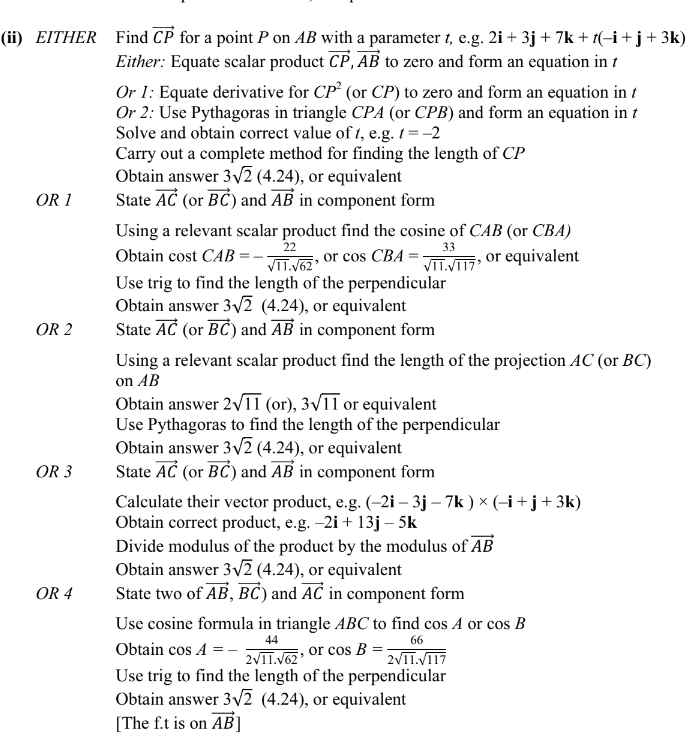Question
(i) By differentiating \(\frac{1}{cosx}\) , show that if y = sec x then\( \frac{dy}{dx}\) = sec x tan x.
(ii) Show that \(\frac{1}{(secx-tanx)}\) ≡ sec x + tan x.
(iii) Deduce that \(\frac{1}{(secx-tanx)^{2}}\) ≡ \(2 sec^{2}\)
x − 1 + 2 sec x tan x.
(iv) Hence show that \(\int_{0}^{\frac{1}{4}\pi }\frac{1}{(secx-tanx)^{2}}dx\)=\(\frac{1}{4}(8\sqrt{2}-\pi )\)
Answer/Explanation
(i) Use correct quotient or chain rule Obtain the given answer correctly having shown sufficient working
(ii) Use a valid method, e.g. multiply numerator and denominator by sec x + tan x, and a version of Pythagoras to justify the given identity
(iii) Substitute, expand
(sec x +\( tan x)^{2}\)
and use Pythagoras once
Obtain given identity
(iv) Obtain integral 2 tan x – x + 2 sec x
Use correct limits correctly in an expression of the form a tan x + bx + c sec x, or
equivalent, where abc 0
Obtain the given answer correctly

Question
(i) Prove the identity tan \(tan2\Theta -tan\Theta sec2\Theta \)
(ii) Hence show that \(\int_{0}^{\frac{1}{6}\pi }tan\Theta sec2\Theta d\Theta =\frac{1}{2}In\frac{3}{2}\)
Answer/Explanation
(i) EITHER: Use tan 2A formula to express LHS in terms of tanθ Express as a single fraction in any correct form Use Pythagoras or cos 2A formula Obtain the given result correctly
OR: Express LHS in terms of sin 2θ, cos 2θ, sin θ and cosθ
Express as a single fraction in any correct form
Use Pythagoras or cos 2A formula or sin(A – B) formula Obtain the given result correctly
(ii) Integrate and obtain a term of the form aln(cos2 ) θ or bln(cos ) θ (or secant equivalents)
Obtain integral \(-\frac{1}{2}\) ln(cos 2 θ ) ln(cos θ ) , or equivalent
Substitute limits correctly (expect to see use of both limits)
Obtain the given answer following full and correct working
Question
Let \(f(x)=\frac{\cos x}{1+\sin x}\)
(a) Show that f′x < 0 for all x in the interval \(-\frac{1}{2}\pi < x< \frac{3}{2}\pi\)
(b) Find \(\int_{\frac{1}{6}\pi }^{\frac{1}{2}\pi }f(x)dx \). Give your answer in a simplified exact form.
Answer/Explanation
Ans
(a) Use quotient or product rule
Obtain derivative in any correct form e.g \(\frac{-\sin x(1+\sin x)-\cos x(\cos x)}{(1+\sin x)^{2}}\)
Use Pythagoras to simplify the derivative
Justify the given statement
(b) State integral of the form a ln (1 + sin x)
State correct integral ln (1 + sin x) A1
Use limits correctly
Obtain answer \(ln\frac{4}{3}\)
Question
Find \(\int_{\frac{1}{6}\pi}^{\frac{1}{3}\pi}x sec^2xdx\). Give your answer in a simplified exact form.
Answer/Explanation
Ans:
Integrate by parts and reach axtanx + b\(\int \)tan x dx
Obtain x tan x – \(\int \) tan x dx
Complete the integration, obtaining a term \(\pm In cosx\), or equivalent
Obtain integral xtan x + In cos x, or equivalent
Substitute limits correctly, having integrated twice
Use a law of logarithms
Obtain answer \(\frac{5}{18} \sqrt{3 \pi} – \frac{1}{2} In 3\), or exact simplified equivalent
Question
(a) Prove that \(\frac{1-\cos 2\theta }{1+\cos 2\theta }=\tan ^{2}\theta\) [2]
(b) Hence find the exact value of \(\int_{\frac{1}{6}\pi }^{\frac{1}{3}\pi } \frac{1-\cos 2\theta }{1+\cos 2\theta }\) [4]
Answer/Explanation
Ans
4 (a) Use correct double angle formula or t-substitution twice
Obtain \( \frac{1-\cos 2\theta }{1+\cos 2\theta }=tan^{2}\theta\) from correct working
4 (b) Express 2 tanθ in terms of 2 secθ
Integrate and obtain terms tanθ – θ
Substitute limits correctly in an integral of the form a tanθ + bθ , where ab≠0
Obtain answer \(\frac{2}{3}\sqrt{3}-\frac{1}{6}\pi \)